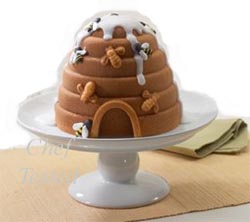
From the Templetons of Petaluma comes this delightful gift of a cake pan. We'll try it today!

"Wore diamonds at our feet..."
Observations from my first years of beekeeping and honey harvesting in a community garden in Northern California. Explorations of regional sustainability, organic culture, slow food and other related topics.
The phrase is from a poem titled "The Kiss," in which the poet recounts a very special osculation, during which "her lips on mine traced a design to show the way bees on a drowsy day..." Some kiss. Some poem.
Why did the phrase stick in my mind? Well, for one thing, the words are individually gorgeous. Suck is an Old English word, with an ancient Latin root. Each breath we take, each drop of mother's milk, is sucked from the world.
Fuchsia found its name more recently; it commemorates the 17th-century German botanist Leonhard Fuchs. In moving from botanist to plant, the word softened, became redolent with fragrance, got juicier. Along our lane in Ireland fuchsia runs wildly rampant.
And honey. There is probably no English word that evokes more succulent imagery: golden, pure, sweet. Honeycombs spilling their luscious liquid. Oozy sensuality.
Add "bees" and "drowsy" and you have a mini-dictionary of delight.
But it is not just the words. It is what they do together. Shakespeare tried it, too: "Where the bee sucks, there suck I." Ulick O'Connor wraps his kiss with every sense, and sucks deeply at the very essence of life.
* American Foulbrood – pearly white larvae change to brown and die after capping. Cappings sink inward and appear perforated with little holes
* European Foulbrood – twisted larvae, light tan or brown in color, capped cells seem perforated
* Nosema – bees appear weak, shivery and crawl around in front of hive, spotting in and around the hive
* Chalkbrood – early Spring disease with infected larvae turning chalky white and hard in appearance
* Sacbrood – viral disease similar to the common cold
* Stonebrood – rare but recoverable
It's normal to find dead drones in the fall, how many I don't know. Drones do not contribute to the needs of a wintering hive and are kicked out as winter approaches. The Queen will produce new drones in the spring to be available for mating over the summer months. Also some of the summer foragers will be dying off as the winter bees are emerging. I believe it is more normal for the older foragers to die off in the field rather than at the hive.
If you are worried about a heavy mite population, you may have to do some treatment. The most significant sign of mite stress shows up as deformed wing virus. Look to see if some of the newly emerging bees have small, deformed wings. If so, you will need to treat aggressively. I use formic acid in the fall and treat with Apistan only as a last resort.
You may need to consider some treatments for your bee hives for mites and diseases.
For Mites you can use:
1. Apistan Strips, active ingredient: Tau-fluvalinate 10.25%.
2. Mite-Away II, also treats for tracheal mites, active ingredient: Formic Acid, a "naturally appearing substance".
3. Apiguard, "a natural and nontoxic" treatment, active ingredient: Thymol gel.
You need to install a drone frame and then treat for mites with this recipe:
1 cup of powdered sugar
½ cup of cinnamon
¼ cup of nutmeg
When the queen lays eggs on the drone frame, take it out and freeze it. Then cut off the caps and check for mites.
You'll need to call Dadant right away and see if there's still time for a treatment. But my biggest foe this year has been the wasps. Wasps could be raiding your hive. Wasps will be killing your larvae.
"Dead larvae is normal. A small hive is normal. But, yeah, sounds like your hive is troubled. Sounds like tracheal mites. You'll want to treat. But then…you know you won't be able to use the honey from a hive in treatment. Do you have a laying Queen? If you don't have a laying Queen, you can re-queen. But it's going to be expensive though. You'll have to get her from Hawaii…
Copulation occurs on the wing, within a drone congregation site 15-30 m above ground (Gary 1963). An aggregation of drones “lazily” fly within their congregation site awaiting the arrival of a queen, and once she appears a fast-paced chase commences where copulation is attempted (Winston 1987). The term “drone comets” visually describe the continual consolidation and disassembly of this following drone swarm (Winston 1987). Koeniger et al. (1979), utilizing a tethered queen, report that the drone clasps the queen in a dorso-ventral position and everts his endophallus directly into the queen’s sting chamber. The drone then becomes “paralysed” and falls backwards (Koeniger et al. 1979). Woyke and Ruttner (1958) state the eversion of the endophallus occurs from haemostatic pressure caused by abdominal muscles. Ejaculation occurs into the bulb portion of the drone’s endophallus prior to full eversion, and semen is discharged through a small opening in the bulb into the queen’s vagina during copulation (Woyke and Ruttner 1958). Winston (1987) figuratively asserts that the drones “explode” their semen into the queen’s copulatory orifice, and consequently toward her oviduct. Through subsequent pressure the bow of the bulb and chitinized plates, the “mating sign,” detaches from the endophallus of the drone and remains inside the queen (Woyke and Ruttner 1958). Winston (1987) concludes this may help thwart the flow of sperm from the queen’s vagina after copulation, and that it does not function as a “mating plug” used to discourage multiple matings. After the pair separate the endophallus is still fully everted with its associated strong pressure, and with loss of the “mating plug” the endophallus may burst at the tip (Woyke & Ruttner 1958). At the end of copulation, the drone falls to the ground and dies either in minutes or hours (Woyke and Ruttner 1958, Winston 1987).
To determine the effect mating has on honey bee queens, the scientists artificially inseminated queens. It's difficult to determine the number of times a queen mates under natural conditions. Some queens were inseminated with the semen from one drone, others with the semen from 10 drones. The scientists then put the queens in hives and observed them.
They found that worker bees paid more attention to the multiply inseminated queens. Worker bees demonstrate what is known as a "retinue response" to their queen; they lick her and rub their antennae on her. The retinue response to the multiply inseminated queens was more pronounced.
"This tells us the workers can tell how many drones the queen has mated with," said Grozinger.
open brood -- little baby bees in their earliest visible stage (eggs are too small to see)
capped brood -- baby bees now covered by wax and on their way
pollen -- different colors from the different flowers and such, stored as food near nursery
nectar -- open cells with the liquid that we think of as honey
honey -- capped cells of nectar, color will indicate age of stores, or possibly season
mite count -- mites are manageable but bad. There's medication (which Sonoma doesn't recommend because they're all about the natural) and there's dusting the bees with confectioners sugar. Sounds way cool to do that!
crazy comb -- wax combs on top or bottom of frames, indicates overcrowded hive. You either add another box or split the hive
spotty brood cells -- the queen is not laying eggs in a patterned formation. She might be on her way out.
old, tired queens -- cue the office jokes! "So Dave, the hive kicked you out, eh?"
wax moths/ants -- bad but somewhat unavoidable. A strong hive will make short work of honey-hunting ants.
foul brood -- bad. very bad. Some states require you to burn any infected hive.